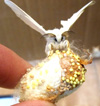 With a desire to more fully understand the little beings that
produce silk which has been the substrate of my artistic work
for over thirty years, I took on a “summer project” to raise some
silk worms in the ahimsa (non-harm) method, allowing a complete
life cycle from egg to moth. Silk worms, specifically the bombyx mori,
have been raised domestically for over 5000 years. They are now
entirely dependant on human beings for their survival. With a desire to more fully understand the little beings that
produce silk which has been the substrate of my artistic work
for over thirty years, I took on a “summer project” to raise some
silk worms in the ahimsa (non-harm) method, allowing a complete
life cycle from egg to moth. Silk worms, specifically the bombyx mori,
have been raised domestically for over 5000 years. They are now
entirely dependant on human beings for their survival.
In mid June, 2010, I ordered 50 silk worm eggs from Oregon. They
arrived in a small film canister by Federal Express. Soon I realized
that the 50 eggs were closer to 300 and included both White
Princess silkworms as well as Golden Zebra silkworms. They would
hatch and increase their body size 10,000 times over their one
month larvae stage, fast enough to keep me awake at night. I had
my hands full.
| My planned schedule: |
Eggs hatch in 6 – 20 days (July 4)
Caterpillars eat for 26 days (July 30)
Spin cocoons over three days ((August 2)
Moths emerge in 21 days (August 23)
Moths lay eggs in two days (August 25) |
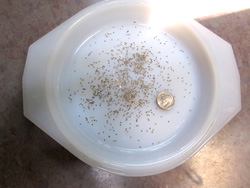 |
On June 26, I spread the tiny eggs on a white dish.
They were no bigger than a pin head. |

The first 20 eggs hatched during the early morning of July 4th,
producing 1/8” tiny worms called kego or “tiny babies,” no
bigger than a pencil lead. They took off looking for food
around the edge of the plate. I learned that they must eat within
4 hours
or die of dehydration. |
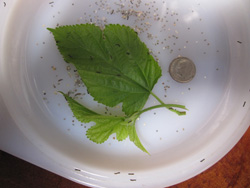 |
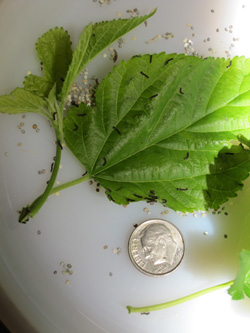 |
Introducing young mulberry leaves (the only leaf bombyx mori silk worms will eat) got their attention and they began munching
along the leaf edges. They rendered a leaf into lace filigree in two hours. |
| In a day or two, as more hatched, I was able to wean the growing caterpillars
to Silk Worm Chow for the next two weeks. Silk Worm Chow is a pulverized
powder that I could reconstitute at home, and is shown here as sliced logs
that I replenished three times a day. |
 |
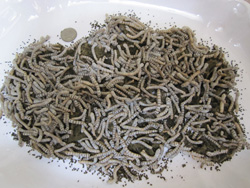 |
They grew —
and more hatched —
and grew.
The final count was 283 worms!!! |
| They shed their outer hairy casing in five ‘instars’ over 28 days, followed by a rapid growth and an increasing appetite. |
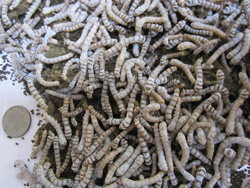 |
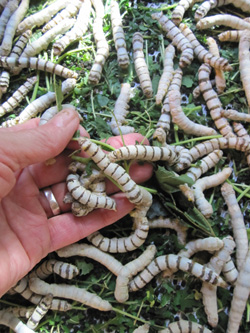 |
At 18 days old they were moved
to mulberry leaves and began
binge
eating
four times a day over the next week. |
By August 1st, at 28 days old,
they started producing silk thread and
gummy sericin from their mouth orifice
— looking for a good place to cocoon.
Spinning began. |
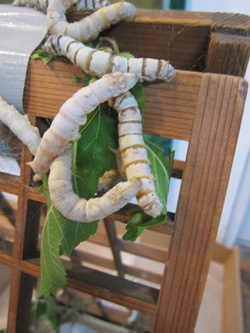 |
 |
Some were still eating
while others cocooned.
Here you can see some ripening mulberries that were of no interest — leaves only,
please. |
Zebra caterpillars (left) spin golden cocoons
and White Princesses (right) spin white cocoons. |
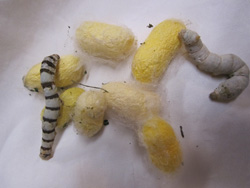 |
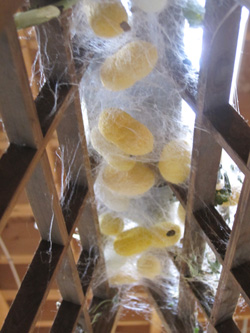 |
They spun in frames, crevasses,
under newspapers
that lined their box. |
| And in egg cartons provided. |
 |
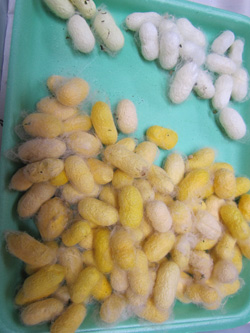 |
In the end, 207 golden zebra
and 34 white princesses made cocoons,
displaying various spin abilities. |
A few days after the last caterpillar made a cocoon, four moths
emerged from their own cocoons, found a mate and laid eggs
— in six hours. |
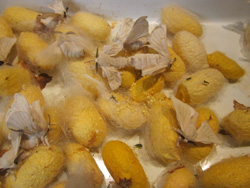 |
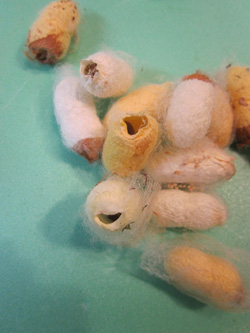 |
As the caterpillar matured in the cocoon, it secreted an alkaline
enzyme that burned a hole in the casing allowing it to emerge as
a moth. In doing so, it broke the 3000’ of silk thread that is usually
‘reeled off’ and instead produced “short end” silk. |
The moths arrive with no eyes or mouths or ability to fly,
but process comb-like antennae
that sense a mate 100’ away. |
 |
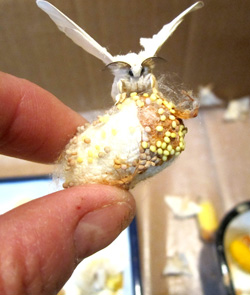 |
They find their beloved and mate in a few hours producing
200 – 500 eggs and ending their happy natural lives.
Birth to death — in 48 days! |
After two months of full-time obsession, and the help of multiple
friends who worked to locate local mulberry trees, hauled garbage
bags of leaves, cleaned trays, fed, observed and did caretaking with
me — I have far greater respect for those whose livelihood is
connected to sericulture — silkworm raising. I hold also hold in awe
and great respect, this miracle that produces lovely silk, as a
natural process of life.
I actually miss the ‘little masters’ as they are called. And now, I must
investigate how to spin these cocoons that I have collected and to use
them in my own personal art work.
With great admiraton,
Dh. Kiranadā August 2010 |














 With a desire to more fully understand the little beings that
produce silk which has been the substrate of my artistic work
for over thirty years, I took on a “summer project” to raise some
silk worms in the ahimsa (non-harm) method, allowing a complete
life cycle from egg to moth. Silk worms, specifically the bombyx mori,
have been raised domestically for over 5000 years. They are now
entirely dependant on human beings for their survival.
With a desire to more fully understand the little beings that
produce silk which has been the substrate of my artistic work
for over thirty years, I took on a “summer project” to raise some
silk worms in the ahimsa (non-harm) method, allowing a complete
life cycle from egg to moth. Silk worms, specifically the bombyx mori,
have been raised domestically for over 5000 years. They are now
entirely dependant on human beings for their survival.















